When summer storms roll through southern Ontario, city officials depend on stormwater management ponds to store runoff, keep pollutants out of lakes and rivers and prevent basements from flooding. Today, however, municipalities are increasingly adding Low Impact Development (LID) technologies to complement those ponds.
Peppered throughout urban environments, these inconspicuous landscape features may take the form of a flower garden along a boulevard, a cluster of trees in the middle of a cul-de-sac or a grass swale at the edge of a park. Underneath, you’ll find carefully engineered systems designed to move stormwater into the soil, via infiltration, and into plants, via evapotranspiration.
As a result, these LID assets reduce the volume of runoff and peak flows, taking pressure off storm drains and sewage treatment plants.
Making LID monitoring easy
Civica Infrastructure knows all about tracking stormwater management infrastructure. Their SWMSoft platform enables municipalities, engineering firms and conservation authorities to collect and track data from stormwater pond inspections, forecast maintenance requirements and provide detailed breakdowns of operational costs. What was missing, the Vaughan-based company realized, was a similar tool that catered to the unique challenges of managing LID assets — including keeping track of where all the features are located.
“Because they’re smaller, there’s going to be quite a large number of them,” explains Civica President Edward Graham. “So having the data management system in place to be able to organize and create a good inventory of all the components at each location is essential.”
Furthermore, while stormwater ponds serve primarily to store and treat excess runoff, LID assets play more complex roles, using vegetation, soil beds and other features to absorb water after a heavy rainfall. That means inspectors need to monitor for a whole range of issues, including ponding, blockages, damaged vegetation, absorption rates and more.
Yes, it’s possible to patch together a system of spreadsheets, maps and inspection records to manage LID assets. But Graham knew that Civica could deliver a much more effective alternative by expanding the capabilities of SWMSoft by integrating with common Geographic Information Systems (GIS).
Teaming up with SOWC to create new software solutions
Civica’s team of stormwater management consultants had a clear vision of what the LID-tracking software should encompass, but the company lacked the resources to make it happen.
That’s where SOWC came in. With funding from the organization’s Advancing Water Technologies (AWT) program, which is supported by the Federal Economic Development Agency for Southern Ontario (FedDev Ontario), Civica was able to partner with Dr. Ed McBean, a professor at the University of Guelph and Canada Research Chair in Water Supply Security.
As an expert in water resource engineering and groundwater modelling, McBean helped the company design an effective system that meets the inspection requirements established by the Ministry of Environment and conservation authorities. Meanwhile, McBean provided access to a software developer from his team to handle the coding.
Together, Civica and McBean created a system that gathers the details inspectors need to ensure their LID assets are performing optimally. “This funding is fantastic,” says Graham. “I can tell you categorically that these products would never have moved [forward] without AWT funding.”
Storming toward full-scale commercialization
The result is the world’s first asset management platform specifically designed for LIDs. “There’s nothing really dedicated for this in the market, because LIDs are a relatively new technology,” says Graham.
Equipped with GIS-enabled mapping capabilities, the mobile-friendly tool lets inspectors keep track of their assets from their smartphones. It makes it easy to gather and organize key information, including survey results, photographs, field notes and more. “You can actually collect data and document whether or not they’re achieving the intended purpose of enhancing the amount of seepage or abstraction in the soil,” Graham explains.
Stormwater management officials throughout Peel Region and the Credit Valley Conservation Authority are now field-testing the optimized inspection tool. Meanwhile, within York Region, both East Gwillimbury and Newmarket have already purchased and deployed the beta version. As these early adopters provide feedback, Civica will continue to fine-tune their system, making it as user-friendly as possible before they launch into full-scale commercialization.
Major market potential
Today, Civica is gearing up to get their software to market. They’ve hired additional staff, including the University of Guelph software developer initially brought on through the AWT project, and they’re in discussions with other municipalities.
Although Graham plans to focus on local customers initially, there are thousands of municipalities across North America. As more and more of these jurisdictions incorporate LID assets into their stormwater treatment plans, they’ll need the right tools to manage them — tools Civica is preparing to deliver.


